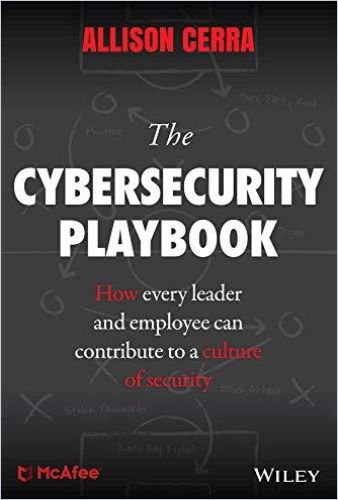Back to 2019?

Hopefully, someone quickly cleaned the coffee grounds out of the coffee machine. Two years ago. Or at least last week. Because if many corporate leaders have their way, it will finally be in use again in the coming weeks, when millions of workers prepare to return to their offices following the end of pandemic restrictions. And:
‘Better coffee’ in the office is still one of the most plausible reasons for returning, say employees when asked.
Once this information dawned on workers, it quickly became clear that the “return to the office” will not be a voluntary one in many cases. In the United States, every state – except Hawaii – will drop indoor mask mandates by the end of March 2022, paving the way for millions of workers to return to their offices.
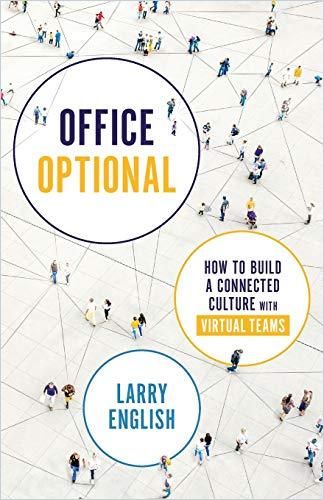
According to WFH Research, which has been conducting remote work surveys of 60,000 US workers for 20 years, the new flexibility of the home office is unabatedly attractive. Nicholas Bloom, William Eberle Professor of Economics at Stanford University and co-founder of WFH Research says that after the COVID-19 pandemic:
Most people want to work from home two or three days a week and come into the office two or three days a week.
What’s more, working from home now even has a rough price tag. The possibility to work from home, respondents of the survey said, is worth about as much as a 10% pay raise – and productivity has not suffered either. So why order them back at all?
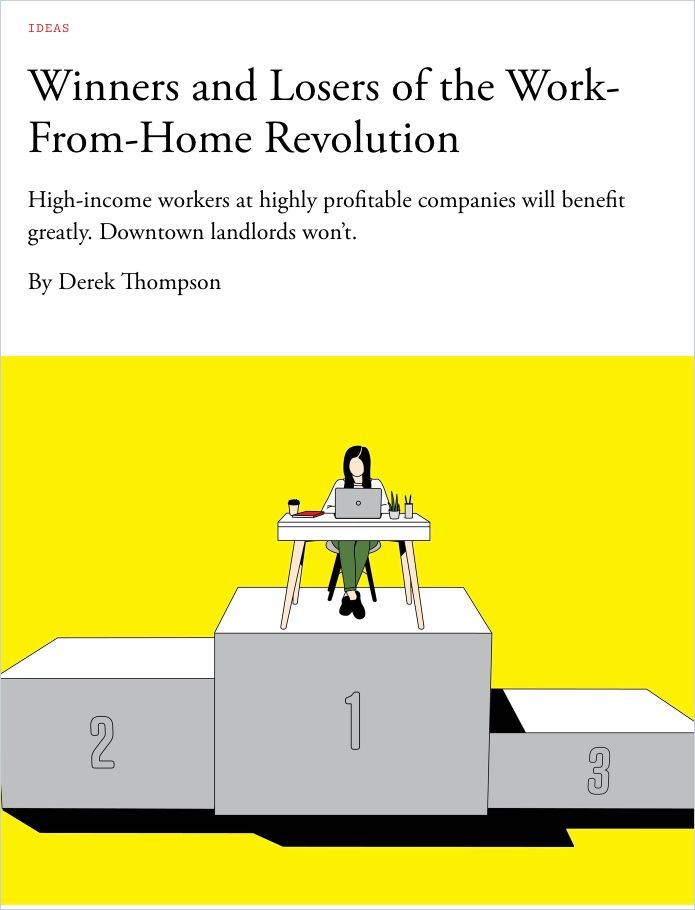
Opponents of the home office are predominantly male, over 50 years old, and do not have kids at home. In the United States, according to a report by the accounting firm Deloitte, about 62% of the board members of Fortune 500 companies belong to this group. They are the ones who now want to get everyone back into the offices.
Take-Aways:
- For companies that depend on succeeding in the war for talent, bringing employees back to the office is difficult – because many high performers don’t want to.
- Anyone who uses the time-honored arguments about the benefits of office work as in 2019 is talking past reality and the target group. People will notice.
- Before you bring people back to the office, work out a plan to do so, communicate transparently and honestly – and most importantly, invest in new office equipment to enable hybrid working.
So let’s take a closer look and scrutinize the arguments.
The Office Advantages…
As a matter of principle, work locations and hours are regulated in employment contracts, and where both are defined in terms of the company’s headquarters and the hours of presence there, there is nothing legally against a broad-based return campaign. However, companies would do well to weigh the pros and cons carefully, to inform direct supervisors in advance and bilaterally about the plans, and to detail in their communications why they have decided to take this step – so that it is comprehensible to all.
When employers list the benefits of returning to the office, the following are often cited:
- Presence – In many companies, you can’t do without a physical presence at all, because production is taking place or because the business wouldn’t run without the presence of employees for other reasons. But even service companies and knowledge companies that have had to make do with remote work for the last two years, know that face-to-face exchanges and meetings in which people look at each other instead of at their screens make communication and collaboration (among those present) easier. The “assembly line” ticking off of tasks and the associated reports in the home office should give way again to more organic togetherness on the spot, and the company culture, which in the recent past was mostly held up in a rather makeshift manner, should blossom again.

Hybrid work is a chance to redefine your culture. Seize the moment.
Business Insider UK- Better infrastructure – Back problems, screaming children, seating issues, awkwardly organized family apartments and the possibly challenging supply of broadband internet – common side effects of home office work – should once again be a thing of the past. Better coffee in the company kitchen? All well and good! But the argument of data security certainly weighs more heavily: Although many companies continue to criminally neglect the issue, the systems in their own offices are often significantly better protected against cyber crime than the often (private) computers of the users in the home office. This is especially relevant to companies that work with sensitive (user) data, which is becoming more and more the case. It appears that a well-protected office IT infrastructure has significant advantages.

Unilever’s Bobby Ford Discusses How to Secure Your Digital Business
WSJ Video Read Summary- Visibility – Introverted employees should finally have the same opportunities to contribute and stand out in the office as those who always have their hand up anyway. It is an open secret that remote work sometimes creates inequalities that first affect visibility, but then also hinder career advancement and better pay.
- Mental health – Word has also spread that sitting around lonely in front of a screen at home is a serious health problem for many who have no family or few social contacts. The warm smile of a co-worker across the office table, the little chat at the fridge with a colleague from the finance department, or lunch at the Italian restaurant next to the company headquarters – many colleagues have missed this exchange very much and suffered from home office isolation.
- Control – Although managers don’t like to admit this publicly, even after two years of virtual collaboration they have trouble managing at a distance because they feel they don’t have the same control over the fulfillment of duties and tasks as they do in the office. No one admits this to employees’ faces, and it’s also kept quiet in communications, but it’s still a reality.
For companies that have already decided to call colleagues back to the corporate floor, it’s worth highlighting these points in the appropriate communications and intensifying their efforts to improve each of them. A few ideas:
- Presence – Make sure that the presence of your employees is really celebrated, especially in the first weeks of their return. Set up meeting zones, an appropriate party and place a welcome gift on the workstations. And make sure the offices are clean, well ventilated and, preferably, modernized when people arrive.
Where woolly mice pile up on magazine issues from spring 2020, no one wants to work. And make sure to think of ‘presence’ not just physically. There are now more people who want to join the action from home – you shouldn’t discriminate against them in reverse now.
- Better infrastructure – A lot has changed in the last two years. Basic workstation equipment now includes a satisfactory webcam, a larger screen and possibly a docking station for home office laptops. If you have installed something new, returning employees may also need to be trained on it – in which case, organize someone from IT to do the introductory work in the first few weeks.
Anyone who talks about a “healthier workplace” should also think again about ergonomics: Standing desks and high-quality office chairs are not a luxury. In meeting and conference rooms, it is now imperative to provide hardware that is suitable for videoconferencing and sufficient (large) screens to make hybrid meetings – which will become even more common – a good experience for everyone. Basically, it also can’t hurt to re-examine the general room layout of offices: Open-plan offices accommodate a lot of people, but are a disaster for people who need to concentrate at work, and those are the ones on whom your success depends. Spacing is perceived and valued fundamentally differently after two years of the pandemic than before.
And if your offices are still dark, the floors covered with 1980s stretch carpeting, and the restrooms barely visible behind uric scale, you should fundamentally refrain from emphasizing the “better infrastructure” rhetorically at all.
- Visibility – Make sure that you welcome your employees individually and seek a conversation with them. Ask: What wishes and fears do they associate with their return? What experiences do they want to have? What did they miss? What will they miss about the home office?
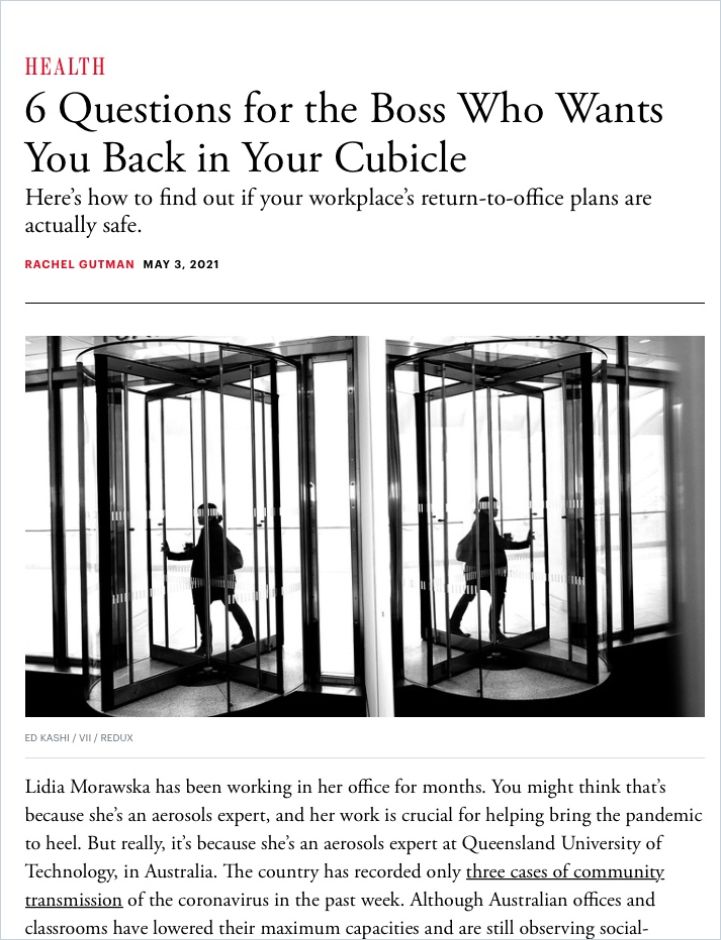
6 Questions for the Boss Who Wants You Back in Your Cubicle
The AtlanticYou should not just acknowledge the results with a nod, but take notes and evaluate them. From this, for example, improvements to the office can sometimes be acted upon fairly quickly and easily. Most of the time, these don’t just involve foosball tables, massage chairs or yoga rooms, but concrete help with their pain points: Simplify, shorten and reduce the cost of commuting (shuttle buses, travel allowances, etc.); make working options and hours more flexible (clocking in and clocking out at the main entrance have had their day); and act to cushion the blow of new hardships (child care compensation, more vacation days, etc.). In a nutshell: If you show your colleagues that you hear them and also take their problems seriously, they will be more likely to come back to the office.
- Mental health – But it’s unlikely that they’ll really want to come back full time. Don’t increase the pressure unnecessarily. Instead, make sure that colleagues can talk openly without having to experience any disadvantages. After two years of being on their own, some colleagues may struggle a bit with the “many” social contacts, demands and changes. Make sure direct reports are especially supported during the transition phase and accommodate all employees where possible. For many, returning to the office is just as challenging and difficult as being abruptly kicked out of it over two years ago.
- Control – Micromanagement has always been a disaster, and will be again. Make sure that colleagues in the office do not feel overly supervised, controlled or monitored. They are not (anymore) used to someone looking over their shoulder. If someone walked in the door without being asked, in recent months it was usually the next generation, not the boss or a colleague from the finance department. Constant interruptions to work – no matter how well-meaning – cause massive productivity losses, so when you return to the office, you should continue to observe the hard-won “do not disturb” rules of the last few months and ensure that they are adapted to the hybrid office culture.
…Are Now Only Valid with Reservations.
The above incomplete list shows that after two years of the COVID-19 pandemic, some of the often-repeated advantages of fixed office spaces no longer need to be. But that’s not all: Between 2019 and 2022, not only have office ideas evolved, but so have your employees. You have seen that what seemed impossible up until 2020 – working from home, in a flexible setting, together with people all over the world, easily, quickly, productively – became possible within a few weeks, and is now very much appreciated by a large proportion of workers.
It is, therefore, appropriate to reflect quite fundamentally on whether fixed corporate offices and the accompanying occupancy by workers still have the advantages they were always thought to have.
“It is with some surprise, even a bit of horror, that I perceive reports of companies that are bringing their employees back into the offices completely – as if nothing had happened,” says Robert Mayr, head of data services provider Datev, in Germany, for example. After all, something has happened. And anyone who tries to “turn back the clock” is taking an enormous risk. Why?
- Labor market situation – In the United States, more and more people are changing jobs, and it is clear that the power on labor markets is shifting more and more in the direction of well-trained talents. They are currently in hot demand. And employers who order them back into the hive against their will are not doing themselves any favors. There are many attractive employers out there – and there will be more and more of them – who offer these people what others don’t want to offer. In this way, companies unintentionally open up large attack surfaces in the battle for talent.
- Progress – Hybrid work models, all experts agree, are the future of work. Those who are now doing a roll backward at the expense of flexibility in time, place and working methods are creating many new challenges for themselves. Companies are unnecessarily limiting their talent pool because a definitive work location is often more of a disadvantage than an advantage. Those who currently live and work in Newark will benefit even more in the future from job offers from New York or Tokyo, regardless of whether they want to live there. And that’s not to mention the costs associated with a change of job and change of location that newly recruited talent from elsewhere incurs for the company.
Employers risk new inequalities within the company: Who gets to work from home in the hybrid world, and who doesn’t? There are rarely enough valid answers to these questions.
Companies must massively upgrade the space they now want to cultivate again, both technically and spatially, to remain competitive (rather than saving it – and the associated rent payments). If they don’t do that, labor, loyalty and morale plummet. Doubly disadvantaged are companies that didn’t use the past two years to invest in making their offices more attractive and are now bringing all their people back: Colleagues are thus taking a trip down organizational and institutional memory lane – but for those who want to, the digitally remastered version of Back to the Future is sure to keep them happy.
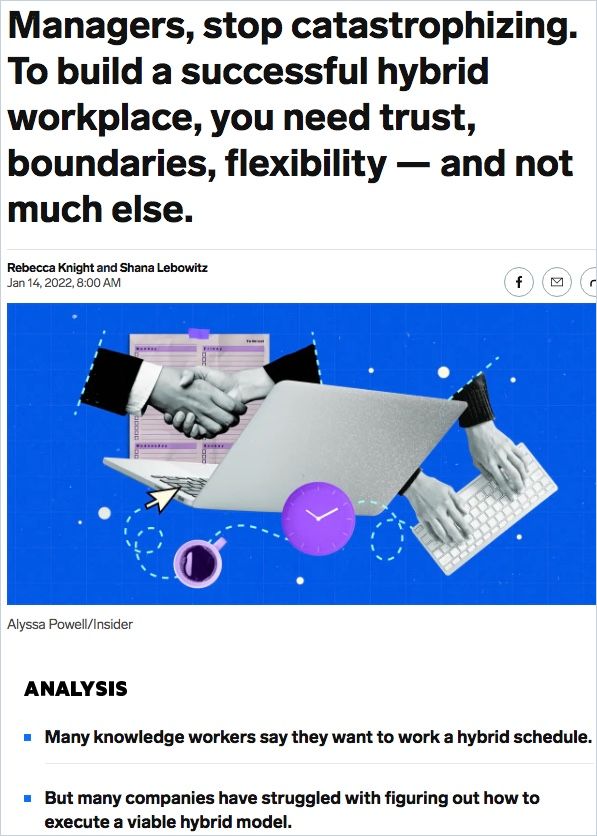
Managers, stop catastrophizing. To build a successful hybrid workplace, you need trust, boundaries, flexibility – and not much else
Medium- Hygiene – Many employees have definitely found working without a mask in a home office more pleasant than sitting masked in an office. Although we’re facing the end of mandatory mask requirements indoors, this only shifts the responsibility for the health of employees back to the companies, which must prepare and implement appropriate protection concepts. Employees who do not want to return to the office due to fears of infection should therefore talk to their superiors as soon as possible – and they must then weigh up how justified the fears are or what can be done about them. Often, “staying” in the home office will be the solution variant for the problem that is easiest to implement. And this, in turn, will be noticed quite quickly by all other colleagues (see unequal treatment above).
In a nutshell: A normalization after the COVID-19 situation of the last few years will certainly be welcomed by all. However, this does not mean that a “new normal” must therefore be the old normal – quite the opposite. Companies, and HR departments, in particular, would be well advised to carefully consider and plan the steps to be taken to call people back to the company offices.
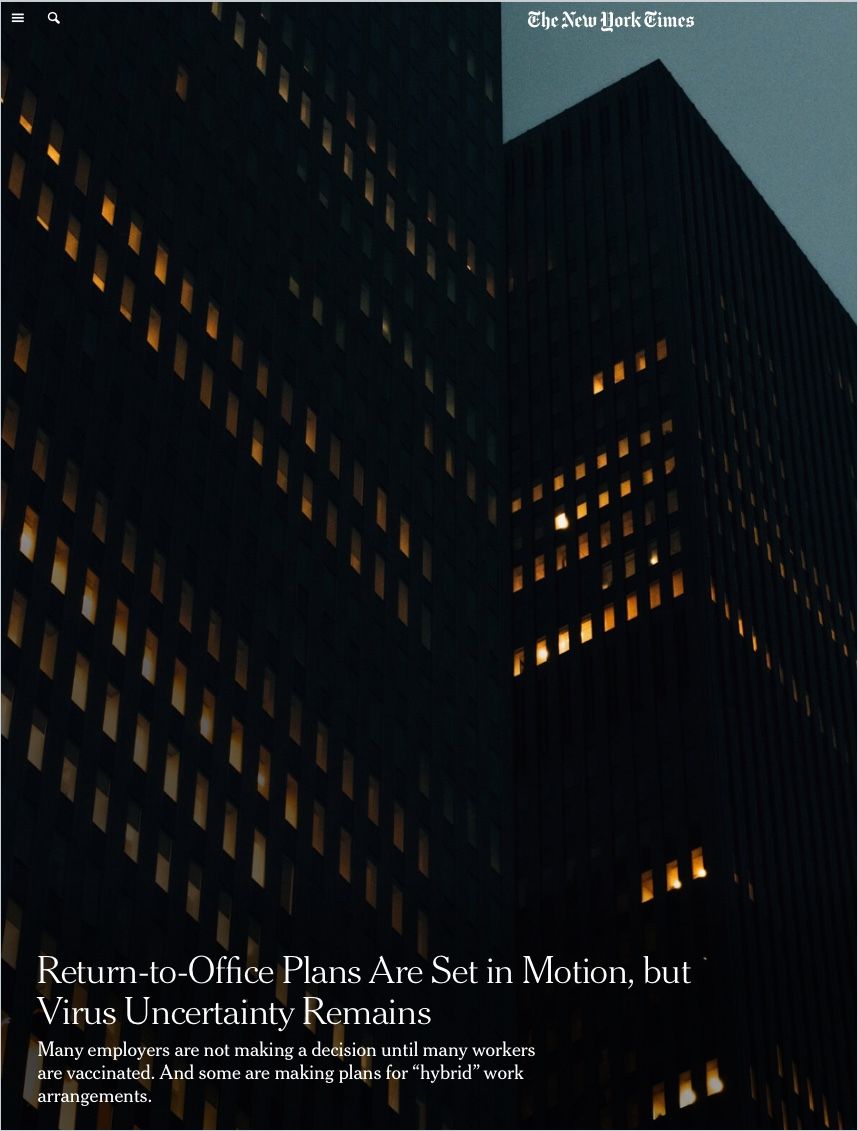
Return to Office Plans Are Set in Motion, but Virus Uncertainty Remains
The New York TimesCertain arguments continue to arise in favor of a presence at the company’s headquarters. Many, however, only in a weakened form. Others have become obsolete, first and foremost that of higher productivity, which is why it is missing from the above list.
No matter what you decide, whether for mandatory presence, against it, or for a mixture: Get people involved beforehand. Develop the new office goals together with them, so that you don’t plan and order without fairly considering the needs of your most important resource.
This is what getAbstract has done several times in the past few years: It became apparent that some employees would very much like to return to the office. However, the majority of respondents opted to continue working from home for a large part or all of their working hours. And in line with these survey results, action was then taken and individual agreements reached on who would work from where. Satisfaction and productivity have risen once again since then.
Find out more about hybrid work models:

